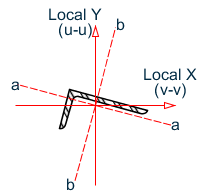D5.B.5.2 Design of Axially Loaded Members
The design of members subject to tension loads alone are performed as per Cl 5.4.3 of the code. The tension capacity is calculated based on yield strength, material factor Γm and cross-sectional area of the member with possible reduction due to bolt holes. When bolt holes need to be considered in the capacity calculations the value used for Γm is 1.2 and the yield strength is replaced with the ultimate tensile strength of the material. The tension capacity is then taken as the smaller of the full section capacity and the reduced section capacity as stated above.
The design of members subject to axial compression loads alone are performed as per Cl 5.4.4 of the code. For members with class 1 2 or 3 section profiles, the full section area is considered in calculating the section capacity. However in case of class 4 sections, the "effective cross-section" is considered to calculate the compressive strength. Also any additional moments induced in the section due to the shift of the centroidal axis of the effective section will also be taken into account as per clause 5.4.8.3 of the code. The effective section properties for class 4 sections will be worked out as given in Cl.5.3.5 of the code.
In addition to the cross section checks, buckling resistance will also be checked for such members. This is often the critical case as the buckling strength of the member is influenced by a number of factors including the section type and the unbraced length of the member. The buckling capacity is calculated as per Cl. 5.5 of the code.
DD ENV 1993-1-1:1992 does not specifically deal with single angle, double angles, double channels or Tee sections and does give a method to work out the slenderness of such members. In these cases, the EC3 DD design module of STAAD.Pro uses the methods specified in BS 5950-1:2000 to calculate the slenderness of these members. Cl. 4.7.10 and table 25 of BS 5950-1:2000 are used in the current version of the EC3 DD design module
Single Angle Sections
Angle sections are unsymmetric and when using BS 5950:2000 table 25, you must consider four axes: two principal, u-u and v-v and two geometric, a-a and b-b. The effective length for the v-v axis, Lvv, is taken as the LVV parameter or LY · KY, if not specified. The a-a and b-b axes are determined by which leg of the angle is fixed by the connection and should be specified using the LEG parameter, see section 5B.6 for more information on the LEG parameter. The effective length in the a-a axis is taken as LY · KY and the effective length in the b-b axis as LZ · KZ.
The following diagram shows the axes for angles which have been defined with either an ST or RA specification and is connected by its longer leg (i.e., a-a axis is parallel to the longer leg).


